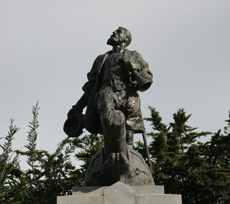
|
|
Ferdinand Magellan |
A Portuguese entrepreneur – A Sindhi industrialist – In Punta Arenas – A Hindu temple – Indian food – Being Indian. (Map this!)
In 1505, a young man from an relatively unknown family undertook a long voyage from Portugal to India, on a route pioneered by Vasco da Gama. The Portuguese were at the height of their maritime prowess and controlled a significant portion of asian trade. Having gained valuable experience the young man proposed a daring expedition to his king, a westerly route to the Spice Islands. Manuel I, for reasons of his own, either jaded by the successes of Vasco de Gama or lack of faith in the plan, declined to fund his expedition. The Spanish monarch, on the other hand, was much intrigued by the proposal and the risky venture. Funded by the Spanish crown, a flotilla of five ships set sail from Sevilla in 1519, found the channel between South America and Tierra del Fuego and became the first known expedition to circumnavigate the earth. The channel they found bears the name of the man who was their leader, Ferdinand Magellan.
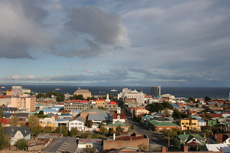
|
|
Punta Arenas |
Patagonia has a knack for attracting a certain type of person. It demands a pioneering spirit, a willingness to endure hardship, an ability to spend time away from friends & family, and vast ambition. It is difficult to make a name for yourself where the path is well trodden but in Patagonia there are many new paths to discover and each new path can carry a name to fame.
As a young man from Sindh looking to make his mark, Bhojrajmal Nandwani wanted to be as far away as he could get from the competition of other Sindhis. Looking at a map of the world he settled on the bustling port city of Punta Arenas, strategically perched on the Straits of Magellan, the same place where the aspiring Portuguese mariner had decided to make his name several centuries earlier.
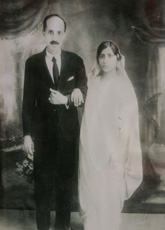
|
|
The ex patriot |
In 1904 Nandwani steamed from British India to Chilean Patagonia. It is difficult to imagine what he thought of Punta Arenas with its rough bars, whores and gold seekers, but his businesses thrived nonetheless. Soon he had a chain of seventeen shops that provided him with a handsome income and allowed him to return to Sindh, where he built the largest and best house in his village.
Ever since the rise of the state of Mohenjedaro, the land of Sindh has been a melting pot of cultures. When asked to name a famous Sindhi the first name that comes to mind is Lal Shahbaz Qalandar, the 12th century saint sacred to both Hindus and Muslims. Traditionally the Hindu people of Sindh have been traders and shopkeepers, formidable businessmen with the experience of generations. According to my friend Nari Bhojwani there are no castes among the Sindhi. “We’re all just Sindhi”, he told me.
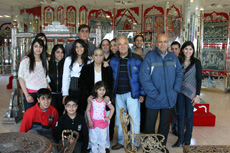
|
|
The Nandwanis |
In 1947 British India was ripped asunder to give birth to the nations of Pakistan and India. The plan that decided which state would belong to which nation was arcane and complicated, Sindh was to be a province of Pakistan. Overnight the Hindus of Sindh were given a choice: 1) Leave and lose their holdings, 2) Convert to Islam, and 3) Be killed. Quite logically Nandwani decided on the first option and through a stop at Jaipur returned to Punta Arenas. After years of neglect the family businesses were in shambles and the Nandwanis had to start their lives over.
Senora Marina, our friend from Santiago, assured us that Punta Arenas was teeming with Indians. So we had expected to find a mini-India with shops and restaurants, similar to Devon avenue in Chicago. Much to our initial disappointment we found no such thing, but over an excellent lunch at his house, our friend Nicolas Alvarez told us “There are the Nandwanis, a powerful Hindu family. Among their many businesses is the biggest Toyota dealership in town”. At the Toyota dealership we made acquaintance with the quiet and affable Nari Bhojwani, son-in-law of Dwarkadas Nandwani, the current patriarch. He invited us to the Southernmost Hindu temple in the world and lunch afterwards.
|
|
The Southernmost Hindu temple |
For a higher resolution video click here
“I am a Chilean with an Indian heart”, Sunil Nandwani told us, over the sumptious lunch cooked for us by Nari’s Indonesian staff. What does it mean to be “Indian”? I had always thought that to be Indian you have to be born and/or spent a large number of years in India. But the Nandwanis hold to their traditions strongly – all have opted for Indian style arranged marriages with Sindhis from around the world and they have Hindu religious ceremonies every Sunday. Nevertheless, Chile surrounds them and pervades them; when I talk with Sunil’s brother Anand his accent and mannerisms remind be of my friend Nicolas, a Chilean. The family lapses easily into Spanish when talking amongst themselves.
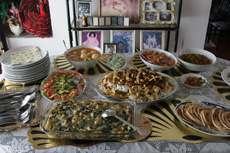
|
|
An Indian feast |
I would guess that this strong identification with a foreign culture comes at a price, especially among the local Chileans. We perceived undercurrents of tensions with the local culture that the Nandwanis keep at an arm’s length. The Hindu temple has been a magnet for graffitti, more so than other buildings in that area. Such defacement of a Church in a Catholic country would be unthinkable.
At a bar in the Patagonian city of Rio Grande we sat with Estancia owners and oil drillers, the conversation flowing freely, lubricated with copious quantities of good Argentine wine. When we mentioned that we had visited the Nandwanis the Argentians all had opinions. “I like them, cars are much cheaper because of them”, said an owner. “My friend ordered a car and they gave him one other than the one he had ordered”, accused another.
“We write a contract and the Chileans don’t understand the terms. Then they break the contract and say we tried to cheat them”, Anand told us, hinting at some of the discord they experience with non-Sindhi’s.

|
|
The Nandwani businesses |
In 1973 the Nandwanis were almost expelled by the Allende government with its Marxist leanings, but managed to stay on and flourish afterward. Given how successful they are in this environment, they will be part of the Patagonian landscape for the forseeable future. “None of us know what will happen tomorrow.”, said Nari Bhojwani pointing upwards, “Only He knows”.
What is it to be Indian, what is it to be American? We are all citizens of the planet.
History of Indians is extremely interesting and especial those from Sind ( those who stay on the bank of river Sindhu. Some people say “from which word Hindu” came)
Daddy
We are following you all the way. can’t wait to see you and discuss all the trip.
We feel so cloisterd here in the North America. What a great experience you are having.
Love to you.
Hello David and Joan,
We will come back to Chico one day and swap stories! Hope you both are doing fine.
PS Why do you feel cloistered?
Neena
Hi Fred,
Totally agree with that sentiment! The sooner we do away with this nationalistic BS that seeks to divide us the better!
Neena
Hello Daddy,
It is amazing what you learn while traveling. Who knew that we would learn about Sindhis from India/Pakistan in Punta Arenas, Chile?
Happy to find indians in this corner of the world, hope to see the temple soon.
I had read about a lone Indian settled in Punta Arenhas in the Reader’s Digest Book of World Travel published back in 1967.
And now I get to read bout that chap and his descendants- Truly amazing- this Internet!
[…] and Reunion, Seychelles and more (like the Sindh settlement in southern Chile at Punta Arenas) https://www.alongdrive.com/videoblog/…-punta-arenas/… depending on where in India the people were coerced (or forced) to leave, the New Hinduism […]
“Overnight the Hindus of Sindh were given a choice: 1) Leave and lose their holdings, 2) Convert to Islam, and 3) Be killed. ”
The following quote is very misleading and author should have avoided this, but he was forced to include it. I’d like to ask him, what were Muslims of India were given the choice?
Hindi-Sindhis live in millions in Sindh province. They are not killed, as this writer has falsely tried to portray.
Kindly provide us the address of the Hindu temple at Punta Arenas, Chile. I’m unable to locate them on google maps. Also it would be great if you can share the contact email of the Indian family residing there. Thanks
my watsapp number 9700162476; i am an indian came to usa for a vacation for 3 more months.
i am fascinated to find a temple in south tip of the world. god bless you all who are making hinduism to live and flurish by which we will enjoy our life by having love for mankind, by serving people, by being blissful happy in life. hinduism is a real way of life by which you can enjoy in real sense.. i wish you to visit india. iam in hyderabad. you can visit haridwar rishikesh which are very pious places
thanks. love and regards to all of you.
yours lovingly,
pathi prakash rao
hi Neena,
So delightful to see your name in my mailbox!! really glad you reached out and it is great to read of your adventures.
Please write back to my email – you had the right one!!
lots of love
I missed this place when I visited Punta Arenas on the way to Antarctica. Next time surely will visit.